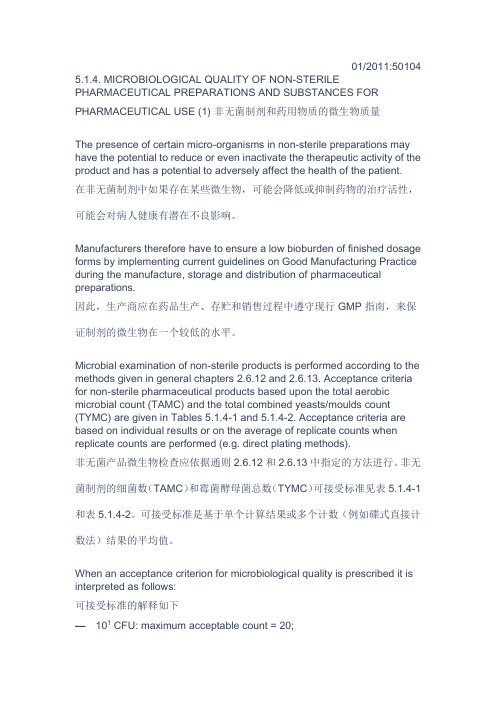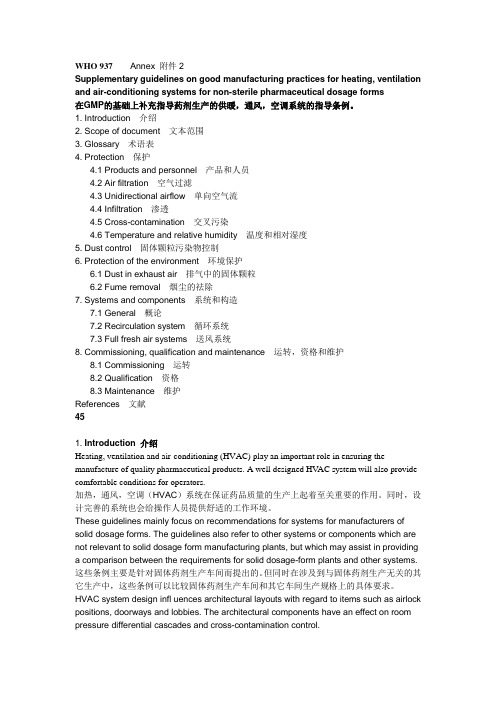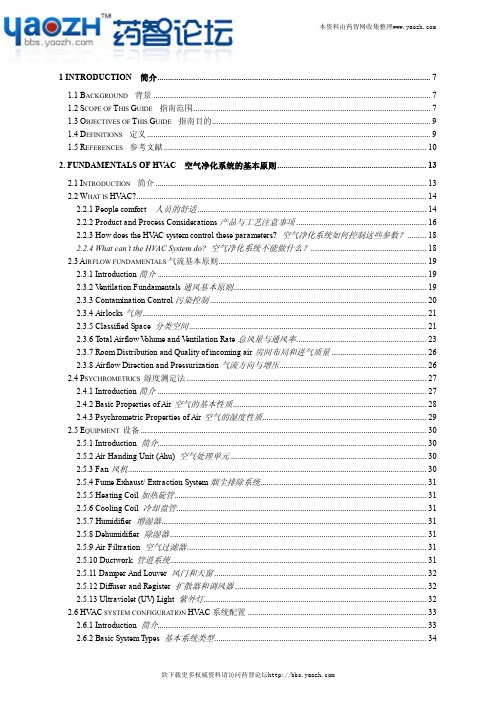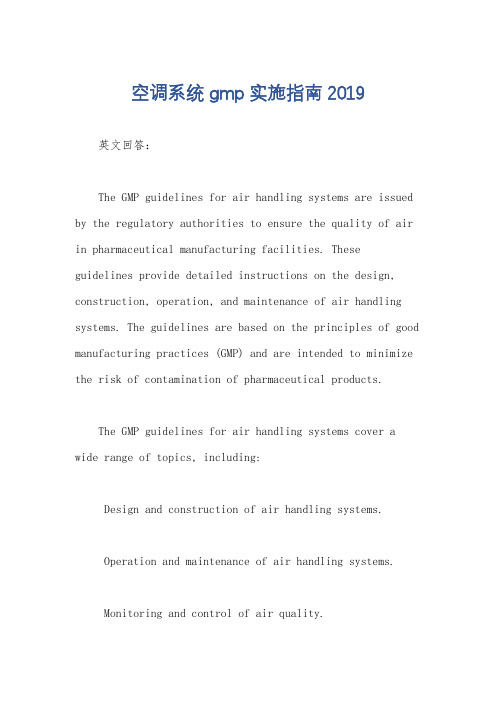非无菌制剂空调系统GMP补充指南 译本
欧盟GMP附录一无菌产品生产2020版_中英文对照版_

欧盟GMP附录一无菌产品生产2020版_中英文对照版_Annex 1 : Manufacture of Sterile ProductsDocument mapSection Number General overview1. Scope Includes additional areas (other than sterile products) where thegeneral principles of the annex can be applied.2. Principle General principles as applied to the manufacture of sterileproducts.3. Pharmaceutical Quality Highlights the specific requirements of the PQS when appliedSystem (PQS) to sterile products.4. Premises General guidance regarding the specific needs for premisesdesign and also guidance on the qualification of premisesincluding the use of Barrier Technology.5. Equipment General guidance on the design and operation of equipment.6. Utilities Guidance with regards to the special requirements of utilitiessuch as water, gas and vacuum.7. Personnel Guidance on the requirements for specific training, knowledgeand skills. Also gives guidance to the qualification ofpersonnel.8.Production and specifictechnologies Discusses the approaches to be taken with regards to aseptic and terminal sterilization processes. Discussesapproaches to sterilization of products, equipment and packaging components. Also discusses different technologies such as lyophilization and Form-Fill-Seal where specific requirements apply.9.Viable and non-viableenvironmental and processmonitoring10.Quality control (QC)11.Glossary This section differs from guidance given in section 4 in that the guidance here applies to ongoing routine monitoring with regards to the design of systems and setting of action limits alert levels and reviewing trend data.The section also gives guidance on the requirements of Aseptic Process Simulation (APS).Gives guidance on some of the specific Quality Control requirements relating to sterile products.Explanation of specific terminology.1 Scope范围The manufacture of sterile products covers a wide range of sterile product types (active substance, sterile excipient, primary packaging material and finished dosage form), packed sizes (single unit to multiple units), processes (from highly automated systems to manual processes) and technologies (e.g. biotechnology, classical small molecule manufacturing and closed systems). This Annex provides general guidance that should be used for the manufacture of all sterile products using the principles of Quality Risk Management (QRM), to ensure that microbial, particulate and pyrogen contamination is prevented in the final product.无菌产品的生产涵盖了广泛的无菌药品类型(活性成分,无菌辅料,内包材和制剂),包装量(从单个单位到多个单位),工艺(从高度自动化系统到人工操作)和技术(例如生物技术,常规小分子生产以及密闭系统)。
WHO《非无菌空调系统指南-2019》解读,增加新的洁净级别,降低高效过滤器要求!

WHO《非无菌空调系统指南-2019》解读,增加新的洁净级别,降低高效过滤器要求!近日,WHO在其技术报告1019中通过了《非无菌产品空调系统指南-第二部分》,解读如下:•风险评估:应对暖通空调系统进行风险评估,风险评估可选择失效模式、影响分析(FMEA)和故障树分析(FTA)。
例如,暖通空调系统中的一个或多个空调机组失效的影响;除尘系统失效;对过滤器、加热管、冷却管、风扇等空调系统组件进行评估,并确定和实施适当的控制措施。
考虑的因素包括但不限于空调机组可能产生的失效,季节变化,原料和产品的性质和种类,人员数量和交叉污染的风险。
•增加新洁净级别,指南指出,除使用A、B、C、D 或ISO 7、ISO 8 外,还可以使用以下分级:•对洁净室定级时,应声明在“空态”、“静态”还是“动态”条件下进行。
•关于压差梯度,建议最小为5pa•对于称量区域,建议设置称量前室、人员气闸室、物料气闸室、带称量罩的称量室、称量后室、清洗区和废料传出设施•对于物料称量的要求,称量位置产生的粉尘应该通过一个穿孔的工作台排出。
称量罩风速应不影响天平的灵敏度。
操作人员既不得阻挡气流,也不应成为原料或产品的污染源。
•应特别注意门的设计,因为门和地板之间的缝隙,门朝低压区打开和推拉门都可能导致不同区域间压差的变化。
•关于洁净走廊的使用,指南指出,对于非无菌口服固体制剂建议使用。
•关于停空调操作,如果制造商决定在特定的时间段如夜间、周末或长时间使用节能模式或关闭某些空调机组,则应注意确保原辅料和产品不受影响。
在这种情况下,决定、程序和记录应有充分的文件记录,并应包括风险评估、标准操作规程(SOP)、记录和验证。
这包括空气处理设备启动和关闭顺序的规程和记录。
•对于再循环系统,应在验证期间确认其新风比。
•关于所使用的过滤器级别,由生产商自行决定•对于再循环系统,应关注能有效对循环空气进行过滤,确保没有交叉污染风险•在同一厂房的不同房间内同时生产不同产品时,应采取适当的控制措施,以确保控制和预防交叉污染•指南给出了不同保护等级推荐的过滤器•关于换气次数,推荐值为6-20次/小时,自净时间为15-20分钟•关于压差,建议为5-20pa之间•不得在空调系统中使用蒸发加湿、雾化加湿和喷雾加湿,因存在微生物污染风险•空气过滤器不应安装在靠近加湿器下游,因为过滤器上的水可能导致细菌生长。
2023版gmp指南无菌制剂解读

2023版gmp指南无菌制剂解读《无菌制剂生产质量管理规范》是药品行业中的一项重要指南,旨在规范无菌制剂的生产过程,确保产品的质量和安全性。
目前最新发布的GMP(Good Manufacturing Practice,良好生产规范)指南版本为2023版。
以下是对2023版GMP 指南中与无菌制剂相关内容的解读(基于一般原则,具体内容可能会有调整):1. 环境控制:GMP要求无菌制剂生产场所必须具备严格的环境空气质量控制,包括空气过滤、清洁和消毒等要求。
空气质量控制范围和级别将根据产品的敏感性和生产条件的不同而有所调整。
2. 人员培训:要求无菌制剂生产人员接受适当的培训,熟悉无菌技术和操作规程,以确保在生产过程中遵循严格的操作要求。
3. 设备验证和清洁程序:GMP要求对相关的生产设备进行验证,并制定适当的清洁程序和验证方法,以确保设备在生产过程中不会引入微生物污染。
4. 原辅材料选择和控制:规范了无菌制剂原辅材料的选择与控制,包括溶剂、滤器、容器等,要求符合质量标准并确保无菌性。
5. 灭菌方法和验证:详细规定了灭菌方法和验证的要求,包括热灭菌、滤灭菌、气体灭菌等。
对灭菌效果的验证必须进行,并记录相关数据。
6. 注射剂制剂和监控:对于无菌注射剂的制造和监控提出了具体要求,包括灌装过程中的监测、封口验证、容器完整性测试等。
7. 生产过程监控:要求对无菌制剂的生产过程进行持续的监控,包括环境监测、生物指示物使用、微生物负荷测试等,以及记录和报告相关数据。
请注意,以上解读只是对2023版GMP指南中与无菌制剂相关内容的一般概述,并不详尽,实际应遵循正式的指南和相关法规。
对于具体的情况和产品,建议参考官方发布的GMP指南或咨询相关的专业人士获取更准确和详细的信息。
WHO非无菌制剂暖通空调GMP指南:第二部分

自2006年WHO发布第一版非无菌制剂暖通空调系统GMP指南,后于2010年、2011年、2015年、2016年、2017年分别发布五版征求意见稿,结构与收录内容几经变更,WHO药物制剂规格专家委员会(ECSPP)于2017年10月第51次会议上商定,非无菌制剂的暖通空调系统指南修订稿将被收录于GMP第一部分。
2018年2月发布《非无菌制剂暖通空调系统GMP指南:第二部分》,在征求公众意见后,将会考虑补充收录。
据WHO发布的修订时间表,2018年5月进行第一次意见整合与评审,2018年7月进行药品和检查工具GXP的讨论,于2018年8月进行第二次公示咨询。
现将此文件进行翻译,希望可以为国内药企进行WHO的GMP验证时提供参考。
若翻译内容有不当之处,还望不吝赐教。
GOOD MANUFACTURING PRACTICES FOR HEATING, VENTILATION AND AIR-CONDITIONING SYSTEMS FOR NON-STERILE PHARMACEUTICAL DOSAGE FORMS: PART 2非无菌制剂暖通空调系统GMP:第二部分INTERPRETATION OF PART 1 – GMP FOR HVAC SYSTEMS第一部分说明-暖通空调系统GMPContents 目录Section 1 and 2. Introduction and Scope第一、二节简介与范围Section 3. Glossary第三节术语Section 4. Premises第四节厂房Section 5. Design of HVAC systems and components第五节暖通空调系统和部件的设计Section 6. Full fresh air and recirculation systems第六节全新风及再循环系统Section 7. Air filtration, airflow direction and pressure differentials第七节空气过滤、气流方向和压差Section 8. Temperature and relative humidity第八节温度和相对湿度Section 9. Dust, vapour and fume control第九节粉尘、蒸汽和烟雾控制Section 10. Protection of the environment第十节环境保护Section 11. Commissioning第十一节试车Section 12. Qualification第十二节确认Section 13. Maintenance第十三节维护Section 1 and 2 : Introduction and Scope第一、二节简介与范围This document represents Part 2 of the HVAC systems guidelines. It contains non-binding examples, drawings, technical representations and interpretation in support of Part 1 of the HVAC systems guidelines.本文件代表第二部分的暖通空调系统指南。
WHO指南 附件8 非无菌产品空调系统指南翻译

目录1 Introduction 简介 (2)2 Scope 范围 (2)3 Glossary 术语 (2)4 Premises 厂房 (4)5 Design of HVAC systems and components 空调系统和组件的设计 (6)6 Full fresh air systems and recirculation systems 全新风系统和再循环系统 (8)7 Air filtration, airflow direction and pressure differentials 空气过滤、气流方向和压差 (8)8 Temperature and relative humidity 温度和相对湿度 (10)9 Dust, vapour and fume control 粉尘、蒸汽和烟雾控制 (10)10 Protection of the environment 环境保护 (11)11 Commissioning 试运行 (11)12 Qualification 确认 (11)13 Maintenance 维护 (12)1 Introduction介绍略2 Scope范围These guidelines focus primarily on GMP for the design, qualification, management and maintenance of HVAC systems in facilities for the manufacture of non-sterile dosage forms.They are intended to complement the guidelines on GMP for pharmaceutical products and should be read in conjunction with the parent guide. The additional standards addressed in these guidelines should therefore be considered supplementary to the general requirements set out in the main principles guide (4).该指南主要适用于非无菌制剂生产设施中空调系统GMP方面的设计、确认、管理和维护。
空调系统gmp实施指南2019

空调系统gmp实施指南2019空调系统GMP实施指南2019前言本指南旨在为空调系统在制药行业的设计、安装、运行和维护提供指导,以确保系统符合GMP(Good Manufacturing Practice,良好生产规范)要求,从而保证药品质量。
1. 设计考虑因素1.1 环境要求- 温度、湿度和压力控制- 空气洁净度等级- 人员和物料流向1.2 系统选型- 中央空调系统与独立空调系统- 全新风系统与再循环风系统- 冷热源选择1.3 布局与布线- 机房、管线和空调箱的合理布置- 易于维护和检修2. 安装与验证2.1 施工要求- 符合GMP洁净室施工规范 - 管线安装质量控制2.2 系统验证- 设计确认(DC)- 安装确认(IC)-运行确认(OQ)-性能确认(PQ)3. 运行与维护3.1 标准操作程序(SOP)- 启动和停止- 监测和记录- 清洁和消毒3.2 预防性维护- 滤芯更换- 部件检查- 润滑保养3.3 变更控制- 系统升级改造- 备件替换4. 监测与纠正措施4.1 关键参数监测- 温湿度-压差-微粒和微生物4.2 偏差调查与纠正- 根本原因分析- 纠正和预防措施5. 培训与文件5.1 人员培训- 操作人员- 维护人员5.2 文件管理- 用户手册- 维护记录- 验证报告结语良好的空调系统对于制药企业来说至关重要。
通过认真实施本指南,将有助于确保药品生产环境的合规性,从而保证产品质量,维护公众健康。
EU-GMP附录1无菌药品2020年02月20日修订草案中英文对照版-2

EU-GMP附录1⽆菌药品2020年02⽉20⽇修订草案中英⽂对照版-2Annex 1 : Manufacture of Sterile Products⽆菌药品的⽣产Document map ⽬录8 Production and Specific Technologies⽣产与具体技术 (2)Terminally sterilized products 最终灭菌产品 (2)Aseptic preparation and processing ⽆菌准备和处理 (2)Finishing of sterile products⽆菌产品的最终处理 (6)Sterilization 灭菌 (8)Sterilization by heat 热⼒灭菌 (10)Moist heat sterilization 湿热灭菌 (11)Dry heat sterilization ⼲热灭菌 (13)Sterilization by radiation 辐射灭菌 (15)Sterilization with ethylene oxide环氧⼄烷灭菌 (15)Filter sterilization of products which cannot be sterilized in their final container⾮最终灭菌药品的⽆菌过滤 (16)Form-Fill-Seal 成型-灌-封 (20)Blow-Fill-Seal 吹-灌-封 (20)Lyophilization 冻⼲ (22)Closed systems 密封系统 (23)Single use systems (SUS) ⼀次性使⽤系统 (24)9 Viable and non-viable environmental & process monitoring 活性和⾮活性环境和⼯艺监测 (26)General 综述 (26)Environmental monitoring 环境检测 (26)Environmental monitoring- non-viable particles ⾮活性粒⼦的环境检测 (27)Environmental and personnel monitoring-viable particles 环境和⼈员的监测—活粒⼦ (29)Aseptic process simulation (APS) (also known as media fill) ⽆菌模拟灌装 (31)10 Quality Control (QC) 质量控制 (38)Glossary 术语 (40)8 Production and Specific Technologies⽣产与具体技术Terminally sterilized products 最终灭菌产品8.1 Preparation of components and materials should be performed in at least a Grade D cleanroom in order to limit the risk of microbial, pyrogen and particulate contamination, so that the product is suitable for sterilization. Where the product is at a high or unusual risk of microbial contamination (e.g. the product actively supports microbial growth, the product must be held for long periods before filling or the product is not processed mostly in closed vessels), then preparation should be carried out in a Grade C environment. Preparation of ointments, creams, suspensions and emulsions should be carried out in a Grade C environment before terminal sterilization.部件和物料的准备⼯作⾄少应在D级洁净室中进⾏,以限制微⽣物、热原和微粒污染的风险,以便使产品适合灭菌。
空调系统 gmp 实施指南

空调系统 gmp 实施指南空调系统GMP实施指南GMP(Good Manufacturing Practice)是指良好的制造规范,是一种保证产品质量和安全的制造标准。
在制药、食品、化妆品等行业中,GMP是必须遵守的标准。
而在空调系统的设计、安装、维护和使用中,也需要遵守GMP标准,以确保空气质量和环境卫生。
以下是空调系统GMP实施指南:1. 设计阶段在空调系统的设计阶段,需要考虑以下因素:(1)空气流动方向:空气流动方向应从洁净区域流向非洁净区域,以避免污染。
(2)过滤器:应选择高效过滤器,过滤效率应符合GMP标准。
(3)材料选择:应选择符合GMP标准的材料,如不锈钢、铝合金等。
(4)维护方便性:设计时应考虑维护方便性,以便于定期清洁和更换过滤器。
2. 安装阶段在空调系统的安装阶段,需要注意以下事项:(1)安装位置:应选择干燥、通风、无尘、无霉、无异味的位置。
(2)密封性:应保证空调系统的密封性,以避免空气污染。
(3)管道布局:管道布局应合理,避免死角和积尘。
(4)安装人员:安装人员应具备相关资质和经验,以确保安装质量。
3. 维护阶段在空调系统的维护阶段,需要注意以下事项:(1)定期清洁:应定期清洁空调系统,包括过滤器、风道、冷凝器等。
(2)更换过滤器:应定期更换过滤器,以保证过滤效率。
(3)维护记录:应建立维护记录,记录维护时间、内容和人员。
(4)维护人员:维护人员应具备相关资质和经验,以确保维护质量。
4. 使用阶段在空调系统的使用阶段,需要注意以下事项:(1)温度控制:应控制空调系统的温度,以保证室内温度适宜。
(2)湿度控制:应控制空调系统的湿度,以避免霉菌滋生。
(3)空气质量检测:应定期检测空气质量,以确保符合GMP标准。
(4)使用人员:使用人员应接受相关培训,了解空调系统的使用方法和注意事项。
空调系统的设计、安装、维护和使用都需要遵守GMP标准,以确保空气质量和环境卫生。
只有这样,才能保证生产过程中的产品质量和安全。
EP 5.1.4 非无菌制剂和药用物质的微生物质量标准(中英文)

01/2011:50104 5.1.4. MICROBIOLOGICAL QUALITY OF NON-STERILE PHARMACEUTICAL PREPARATIONS AND SUBSTANCES FOR PHARMACEUTICAL USE (1) 非无菌制剂和药用物质的微生物质量The presence of certain micro-organisms in non-sterile preparations may have the potential to reduce or even inactivate the therapeutic activity of the product and has a potential to adversely affect the health of the patient.在非无菌制剂中如果存在某些微生物,可能会降低或抑制药物的治疗活性,可能会对病人健康有潜在不良影响。
Manufacturers therefore have to ensure a low bioburden of finished dosage forms by implementing current guidelines on Good Manufacturing Practice during the manufacture, storage and distribution of pharmaceutical preparations.因此,生产商应在药品生产、存贮和销售过程中遵守现行GMP指南,来保证制剂的微生物在一个较低的水平。
Microbial examination of non-sterile products is performed according to the methods given in general chapters 2.6.12 and 2.6.13. Acceptance criteria for non-sterile pharmaceutical products based upon the total aerobic microbial count (TAMC) and the total combined yeasts/moulds count (TYMC) are given in Tables 5.1.4-1 and 5.1.4-2. Acceptance criteria are based on individual results or on the average of replicate counts when replicate counts are performed (e.g. direct plating methods).非无菌产品微生物检查应依据通则2.6.12和2.6.13中指定的方法进行。
世界卫生组织HVAC非无菌制药指南(中英对照)WHO_937

WHO 937 Annex 附件2Supplementary guidelines on good manufacturing practices for heating, ventilation and air-conditioning systems for non-sterile pharmaceutical dosage forms在GMP的基础上补充指导药剂生产的供暖,通风,空调系统的指导条例。
1. Introduction 介绍2. Scope of document 文本范围3. Glossary 术语表4. Protection 保护4.1 Products and personnel 产品和人员4.2 Air filtration 空气过滤4.3 Unidirectional airflow 单向空气流4.4 Infiltration 渗透4.5 Cross-contamination 交叉污染4.6 Temperature and relative humidity 温度和相对湿度5. Dust control 固体颗粒污染物控制6. Protection of the environment 环境保护6.1 Dust in exhaust air 排气中的固体颗粒6.2 Fume removal 烟尘的祛除7. Systems and components 系统和构造7.1 General 概论7.2 Recirculation system 循环系统7.3 Full fresh air systems 送风系统8. Commissioning, qualification and maintenance 运转,资格和维护8.1 Commissioning 运转8.2 Qualification 资格8.3 Maintenance 维护References 文献451. Introduction 介绍Heating, ventilation and air-conditioning (HVAC) play an important role in ensuring the manufacture of quality pharmaceutical products. A well designed HV AC system will also provide comfortable conditions for operators.加热,通风,空调(HVAC)系统在保证药品质量的生产上起着至关重要的作用。
IPEC全文译稿中英文对照

FOREWORD 前言The quality of excipients is critical to assure the safety, quality and efficacy of medicines. Excipients have a wide range of applications and are essential components of the drug product formulation. Characteristics that excipients impart to formulated drug products include cosmetic appearance, stability and delivery of the active ingredient. Therefore, applying appropriate Good Manufacturing Practice (GMP) principles to excipients is essential. 辅料的质量对保证药品的安全、质量和功效是至关重要的。
辅料的应用范围广泛,是药品生产配方的基本成分。
辅料的特性直接影响药品的配方,包括化妆品的外观、稳定性和活性成分的输送。
因此,应用适当的GMP 规则是辅料的基础。
In contrast to finished dosage forms and Active Pharmaceutical Ingredients (APIs), there are no specific GMP regulations for excipients. In addition, there are a large number of applications of this diverse range of materials which makes the development of excipient GMP guidelines challenging. However, there is a general expectation that excipients are manufactured to recognised GMP principles.与制剂和原料药相比,没有明确的针对辅料的GMP的规则。
非无菌药品空调系统指南-2018中英文

非无菌药品空调系统指南-2018中英文全文共3篇示例,供读者参考篇1Non-Sterile Drug HVAC System Guidelines - 2018IntroductionThe Non-Sterile Drug HVAC System Guidelines - 2018 aim to provide comprehensive and up-to-date guidance on the design, installation, operation, and maintenance of HVAC systems for facilities where non-sterile drugs are manufactured, stored, or distributed. The guidelines are intended to ensure that HVAC systems in such facilities are able to maintain appropriate environmental conditions to prevent contamination, degradation, or adulteration of non-sterile drugs.Key Considerations1. Design: The design of the HVAC system should take into account the specific requirements of the facility, including the type and volume of non-sterile drugs being handled, the layout of the facility, and local environmental conditions. The system should be capable of providing adequate ventilation,temperature control, and humidity control to ensure the stability of the drugs.2. Installation: The installation of the HVAC system should be carried out by qualified professionals in accordance with relevant regulations and industry best practices. Proper installation is essential for the system to function effectively and efficiently.3. Operation: The HVAC system should be operated and monitored regularly to ensure that it is functioning as intended. This includes regular checks of temperature, humidity, and air pressure levels, as well as routine maintenance of filters, ducts, and other components.4. Maintenance: Regular maintenance of the HVAC system is crucial to prevent breakdowns and ensure the system continues to operate at peak efficiency. This includes changing filters, cleaning ducts, inspecting components for wear or damage, and addressing any issues promptly.ConclusionAdhering to the Non-Sterile Drug HVAC System Guidelines - 2018 is essential for ensuring the safety, quality, and efficacy of non-sterile drugs produced or stored in a facility. By following the guidelines, facility operators can maintain a clean andcontrolled environment that minimizes the risk of contamination and protects the integrity of the drugs. Compliance with the guidelines also helps to meet regulatory requirements and industry standards, contributing to the overall success of the facility.篇2Non-sterile Drug Air Conditioning System Guidelines - 2018Introduction:The Non-sterile Drug Air Conditioning System Guidelines provide recommendations for the design, installation, operation, and maintenance of air conditioning systems for non-sterile drug manufacturing facilities. These guidelines aim to ensure that the air quality within these facilities meets the requirements for the production of safe and effective medications.Design:The design of the air conditioning system should take into consideration the specific needs of the non-sterile drug manufacturing process. The system should be capable of providing a clean and controlled environment with appropriate temperature, humidity, and airflow parameters. The layout of thesystem should also allow for easy access for maintenance and cleaning.Installation:The installation of the air conditioning system should be carried out by qualified professionals following industry best practices and local regulations. Proper installation is essential to ensure the efficient operation of the system and to prevent contamination of the manufacturing environment. Regular inspections should be conducted to verify the correct functioning of all components.Operation:The operation of the air conditioning system should be performed by trained personnel who understand the requirements for maintaining air quality in a non-sterile drug manufacturing facility. Monitoring of temperature, humidity, and airflow should be conducted regularly to ensure that the system is functioning as intended. Any deviations from the specified parameters should be addressed promptly to prevent any impact on product quality.Maintenance:Regular maintenance of the air conditioning system is essential to ensure its continued effectiveness. Filters should be replaced as needed, and all components should be inspected for signs of wear or damage. Cleaning of ducts and vents should be carried out regularly to prevent the buildup of contaminants. Any issues identified during maintenance should be addressed promptly to prevent any impact on product quality.Conclusion:The Non-sterile Drug Air Conditioning System Guidelines provide important recommendations for ensuring the air quality within non-sterile drug manufacturing facilities meets the necessary standards. By following these guidelines, manufacturers can ensure the production of safe and effective medications for consumers worldwide.篇3Non-Sterile Drug Products Air Conditioning System Guide - 2018Introduction:The proper design, installation, and maintenance of air conditioning systems in non-sterile drug product manufacturing facilities are critical to ensuring product quality and patientsafety. The guidelines outlined in this document are intended to assist pharmaceutical manufacturers in the implementation of best practices for the operation of air conditioning systems in non-sterile drug product facilities.Design:The design of an air conditioning system for a non-sterile drug product facility should be based on the specific requirements of the products being manufactured, as well as regulatory guidelines and industry standards. The system should be designed to provide adequate airflow, temperature, and humidity control to meet the needs of the manufacturing process.Installation:Proper installation of the air conditioning system is essential to ensuring its effectiveness and reliability. All components of the system should be installed according to manufacturer specifications and industry best practices. Regular maintenance and calibration of the system should also be conducted to ensure proper functioning.Maintenance:Regular maintenance of the air conditioning system is essential to prevent system failures and ensure product quality. Maintenance activities should include cleaning and inspection of air filters, coils, and ductwork, as well as monitoring and calibration of temperature and humidity control systems. Regular testing of the system should also be conducted to verify its performance.Conclusion:The proper design, installation, and maintenance of air conditioning systems in non-sterile drug product facilities are essential to ensuring product quality and patient safety. By following the guidelines outlined in this document, pharmaceutical manufacturers can ensure the effectiveness and reliability of their air conditioning systems, thereby safeguarding the quality of their products.。
ISPE HVAC(翻译版)国际制药工程协会对空调系统的基准指南

gmp指南文件补发管理

gmp指南文件补发管理英文回答:GMP (Good Manufacturing Practice) refers to a set of guidelines and regulations that ensure the quality andsafety of pharmaceutical products. These guidelines cover various aspects of the manufacturing process, including facilities, equipment, personnel, documentation, andquality control.GMP guidelines are essential for pharmaceutical companies to follow in order to meet regulatoryrequirements and ensure the consistent production of high-quality drugs. These guidelines are enforced by regulatory authorities such as the FDA (Food and Drug Administration)in the United States and the EMA (European Medicines Agency) in Europe.One important aspect of GMP is the management of document control, specifically the issuance and control ofdocuments. Document control is crucial to ensure that only the latest and approved versions of documents are used in the manufacturing process. This helps prevent errors, inconsistencies, and potential risks to patient safety.To effectively manage the issuance of GMP documents, a document control system should be in place. This system should include procedures for document creation, review, approval, distribution, and archiving. It should also have mechanisms to track and monitor document revisions and ensure that obsolete versions are removed from use.For example, in my previous role as a Quality Assurance Officer in a pharmaceutical company, I was responsible for managing the issuance of GMP documents. Whenever a new document was created or an existing one was revised, I would ensure that it went through the necessary review and approval process. Once approved, I would distribute the document to the relevant personnel, making sure that they received the latest version.In addition to the document control system, effectivecommunication is also crucial in managing document issuance. Clear instructions and notifications should be provided to personnel regarding the availability of new documents or revisions. This can be done through email notifications, bulletin boards, or even in-person meetings.中文回答:GMP(良好生产规范)是一套确保制药产品质量和安全的指南和规定。
空调系统gmp实施指南2019

空调系统gmp实施指南2019英文回答:The GMP guidelines for air handling systems are issued by the regulatory authorities to ensure the quality of air in pharmaceutical manufacturing facilities. These guidelines provide detailed instructions on the design, construction, operation, and maintenance of air handling systems. The guidelines are based on the principles of good manufacturing practices (GMP) and are intended to minimize the risk of contamination of pharmaceutical products.The GMP guidelines for air handling systems cover a wide range of topics, including:Design and construction of air handling systems.Operation and maintenance of air handling systems.Monitoring and control of air quality.Personnel training.Validation of air handling systems.The guidelines are regularly updated to reflect the latest scientific and technological developments. The 2019 edition of the GMP guidelines for air handling systems is the most recent version of the guidelines.The GMP guidelines for air handling systems are an essential resource for pharmaceutical manufacturers. By following the guidelines, manufacturers can ensure that their air handling systems are designed, constructed, operated, and maintained in a way that minimizes the risk of contamination of pharmaceutical products.中文回答:空调系统gmp实施指南2019是监管机构颁布的,以确保制药生产设施中的空气质量。
WHO公布非无菌制剂用HVAC系统指南草案

WHO公布非无菌制剂用HVAC系统指南草案WHO publishes draft guideline for HVAC systems for non-sterile pharmaceutical dosage formsWHO公布非无菌制剂用HVAC系统指南草案Nearly all guidelines addressing the requirements with regard to HVAC systems or air qualities focus on the manufacture of sterile medicinal products. This is especially true for the Annex 1 of the EU GMP Guideline.几乎所有关于HVAC系统或空气质量的指南都在关注的是无菌药品的生产,特别是EU GMP指南的附录1.The WHO now published a revised working document of the guideline for public consultation which specifically addresses the requirements for HVAC systems used during the manufacture of non-sterile pharmaceutical dosage forms. The version valid so far dates back to 2011 and is contained in the WHO Technical Report Series, No. 961 as Annex 5 (Supplementary guidelines on good manufacturing practices for heating, ventilation and air-conditioning systems for non-sterile pharmaceutical dosage forms). The main changes are the integration of sample layouts (such as for weighing and dispensing) in the chapter "Premises" and a revision of the chapter "Commissioning, Qualification and Validation". Furthermore, a separate chapter now is devoted to maintenance.WHO现在公布了修订后的工作文件征求意见,其中特别强调了非无菌药品制剂生产用HVAC系统的要求。
本附录适用于非无菌原料药生产及无菌原料药生产中非无...

附录2:原料药第一章范围第一条本附录适用于非无菌原料药生产及无菌原料药生产中非无菌生产工序的操作。
第二条原料药生产的起点及工序应当与注册批准的要求一致。
第二章厂房与设施第三条非无菌原料药精制、干燥、粉碎、包装等生产操作的暴露环境应当按照D级洁净区的要求设臵。
第四条质量标准中有热原或细菌内毒素等检验项目的,厂房的设计应当特别注意防止微生物污染,根据产品的预定用途、工艺要求采取相应的控制措施。
第五条质量控制实验室通常应当与生产区分开。
当生产操作不影响检验结果的准确性,且检验操作对生产也无不利影响时,中间控制实验室可设在生产区内。
第三章设备第六条设备所需的润滑剂、加热或冷却介质等,应当避免与中间产品或原料药直接接触,以免影响中间产品或原料药的质量。
当任何偏离上述要求的情况发生时,应当进行评估和恰当处理,保证对产品的质量和用途无不良影响。
第七条生产宜使用密闭设备;密闭设备、管道可以安臵于室外。
使用敞口设备或打开设备操作时,应当有避免污染的措施。
第八条使用同一设备生产多种中间体或原料药品种的,应当说明设备可以共用的合理性,并有防止交叉污染的措施。
第九条难以清洁的设备或部件应当专用。
第十条设备的清洁应当符合以下要求:(一)同一设备连续生产同一原料药或阶段性生产连续数个批次时,宜间隔适当的时间对设备进行清洁,防止污染物(如降解产物、微生物)的累积。
如有影响原料药质量的残留物,更换批次时,必须对设备进行彻底的清洁。
(二)非专用设备更换品种生产前,必须对设备(特别是从粗品精制开始的非专用设备)进行彻底的清洁,防止交叉污染。
(三)对残留物的可接受标准、清洁操作规程和清洁剂的选择,应当有明确规定并说明理由。
第十一条非无菌原料药精制工艺用水至少应当符合纯化水的质量标准。
第四章物料第十二条进厂物料应当有正确标识,经取样(或检验合格)后,可与现有的库存(如储槽中的溶剂或物料)混合,经放行后混合物料方可使用。
应当有防止将物料错放到现有库存中的操作规程。
- 1、下载文档前请自行甄别文档内容的完整性,平台不提供额外的编辑、内容补充、找答案等附加服务。
- 2、"仅部分预览"的文档,不可在线预览部分如存在完整性等问题,可反馈申请退款(可完整预览的文档不适用该条件!)。
- 3、如文档侵犯您的权益,请联系客服反馈,我们会尽快为您处理(人工客服工作时间:9:00-18:30)。
非无菌制剂空调系统GMP补充指南
1、介绍
2、文件范围
3、术语表
4、保护
4.1 产品和人员
4.2 空气过滤
4.3 单向气流
4.4 渗透
4.5 交叉污染
4.6 温度和相对湿度
5、粉尘控制
6、环境保护
6.1 废气中粉尘
6.2 除烟
7、系统和部件
7.1 总则
7.2 再循环系统
7.3 完全新风系统
8、试车、确认和维护
8.1 试车
8.2 确认
8.3 维护
参考文献
1、介绍:
空调系统在保证优质药品生产中起到重要的作用。
设计良好的空调系统应为操作者提供舒适的环境。
本指南着重为固体制剂生产企业空调系统提出一些建议,同时也涉及与固体制剂厂房不相关的其它系统或部件,但有助于不同固体制剂厂房和其它系统要求的比较。
空调系统设计影响到建筑布局,如气闸间位置、门口和门厅。
建筑部件对房间压差级差和交叉污染控制产生影响。
预防污染和交叉污染是空调系统的一个重要设计因素。
在制药厂房设计阶段,空调系统的设计应考虑到这些关键方面的内容。
温度、相对湿度和通风应适宜,且在正常生产、贮存,或设备精确运行时不得对药品的质量产生不良影响。
本文的目的是为药品生产企业和检查人员关于制药厂房空调系统的设计、安装、确认和维护提供指导作用。
本文是世界卫生组织GMP的补充指南,阅读本文时应结合WHO GMP。
2、文件范围:
本指南着重强调固体制剂生产厂房空调系统的设计和GMP要求。
大部分用于生产固体制剂厂房的设计原理也同时适用于其它厂房,如生产液体制剂、霜剂和软膏的厂房。
本指南未覆盖无菌制剂生产厂房的设计要求。
本文也是GMP检查官使用的一个基础指南。
对于GMP要求和设计参数并未做出明文规定。
由于有多种因素影响洁净区环境,因此很难孤立地对某一特定的参数做出明确要求。
许多企业拥有自己的工程设计和确认标准,且这些要求各企业间各有千秋。
为了达到设计既高效又节约成本,每一个项目在参数设计时应根据实际情况而定,与此同时仍需符合法定要求,且能保证药品质量和安全不打折扣。
本指南中提出的三大主要方面是空调系统在产品保护、人员保护和环境保护中所起到的中心内(图1)。
图1,本指南根据图表中列出的顺序讲述了不同的系统标准。
GMP生产环境
产品保护人员保护环境保护
污染(产品及人员)防止与粉尘接触防止粉尘直排
防止产品交叉污染防止与烟雾接触防止烟雾直排
正确的温湿度舒适的工作环境防止污水直排
系统
系统验证
3、术语表(略)
4、保护
4.1 产品和人员
4.1.1 生产药品的原料、产品、器皿和设备暴露在环境中,该区域应划分为洁净区。
4.1.2 某一特定洁净区等级的划分受许多条件的影响,这些条件应在设计和确认阶段应加以考虑。
为了建成一个高效的洁净区,要求合理平衡不同的标准。
4.1.3 需要考虑的一些基本条件应包括:
.厂房光洁度和结构
.空气过滤
.换气率或冲刷率
.空气终端位置和定向气流
.温度
.湿度
.物流
.人流
.设备搬迁
.所做的工艺
.外部空气条件
.房间内人员数量
.产品类型
4.1.4 空气过滤和换气率应能保证达到确定的洁净区等级。
4.1.5 洁净区等级应由企业和设计者确定,需考虑各种关键参数。
最主要是换气次数的设定应达到所要求的洁净等级。
4.1.6 换气次数通常设定在每小时6到22次,由以下因素综合决定:
.所要求的保护程度
.送风的质量及过滤
.生产过程中产生的粒子数
.操作人员产生的粒子数
.房间的构造,新风和回风口的位置
.是否有足够的空气达到截留效果
.是否有足够的空气带走房间内产生的热量
.是否有足够的空气维持所要求的房间压力
4.1.7 在划分洁净等级时,生产企业应说明其是在“空态”(图2)、“静态”(图3)和“动态”(图4)的条件下测得。
4.1.8 “空态”下测试房间等级应在裸露的房间内进行,没有设备也没有人员操作。
4.1.9 “静态”下测试房间等级应在安装有设备的房间内进行,但没有人员。
由于大量的粉尘在固体制剂厂房内产生,因此多数洁净区等级测试在“静态”条件下进行。
4.1.10 “动态”下测试房间等级通常在正常生产条件下进行,房间内有设备和操作人员。
“动态”条件下测试的房间通常应能经过短暂的自净达到“静态”
的条件。
自净时间须经过验证得出,一般应在20分钟以内。
图2,“空态”条件
图3,“静态”条件
图4,“动态”条件
4.1.11 所有物料和产品在生产的各个阶段应防止污染和交叉污染(参见
5.5交叉污染控制)。
注意:污染物的产生可能来自不适当的厂房(例如:粗糙的设计、布局或光洁度),拙劣的清洗方法,人员带入的污染物,及糟糕的空调系统。
4.1.12 悬浮污染物应通过有效的通风得以控制。
4.1.13 外来污染物应通过送风的有效过滤而得以去除。
(参见图5壳式厂房布局例子,加强截留效果,防止外来污染物进入。
)
4.1.14 内部污染物应通过房间内污染物的稀释和冲洗,或经置换气流得以控制。
(参见图6和图7悬浮污染物冲洗方法例子。
)
4.1.15 根据产品要求的保护级别,悬浮粒子和过滤程度应作为关键因素。
4.1.16 不同区域的保护和空气洁净等级的判定应根据生产的产品、所用的工艺和产品降解敏感性而定(表1)。
表1,保护级别举例
级别条件区域例子
1级普通区一般生产区和维修区,如仓库和外包
2级保护区应采取措施保护所暴露的药用起始原料和产品免受
污染和交叉污染的区域,如生产、内包和备料区
3级受控区防止药用起始原料产品污染或降解的应加以规定、
控制、监督的特定生产环境区域
图5,壳式污染截留控制概念
注意:工艺核心区应是控制最严格的洁净区,四周为洁净度等级较低一级的洁净区域。
图6,脏空气紊流稀释
图7,脏空气单向置换
4.2 空气过滤
注意:空气过滤的程度在污染预防和交叉污染控制中起着至关重要的作用。
4.2.1 不同适用要求过滤器的类型取决于大气和回风(如合适)的质量以及换气次数。
表2给出了制药厂房不同保护级别相应的建议过滤级别。
表2,不同保护级别和推荐的过滤类型
保护级别推荐的过滤类型
1级仅需初效过滤器(如EN779 G4过滤器)
2级和3级使用100%新风生产厂房:初效+中效过滤器(如EN779 G4过
滤器+F8过滤器)
2级和3级应用新风加回风的生产厂房(存在潜在的交叉污染):初效+
中效+高效过滤器(如EN779 G4过滤器+F8过滤器+EN1822 H13
过滤器)
注意:上表中提到的过滤器等级与EN1822 和EN779检验标准有关。
(EN779 过滤器等级从G1到F9,EN1822过滤器等级从H10到U16。
)
4.2.2 过滤器类型应始终与标准检验方法结合起来,因为作为实际的过滤效果易产生误导。
(对于同一种过滤器,每一种不同的检验方法会导致不同的结果。
)(见图8)
4.2.3 在选择过滤器时,生产企业还应考虑其它因素,如受到污染的大气状况,当地法规和特定产品要求。
良好的初滤可延长下游较昂贵过滤器的使用期限。
4.2.4 在选择空调系统部件时应特别注意其材质不得成为污染源。
任何可能在气流在脱落微粒或引起细菌污染的空调部件应安装在终端过滤器的上游。
4.2.5 通风调节阀、过滤器和其它装置在设计和安装时应考虑便于从生产区外(维修井或维修通道)进入维修操作。
4.2.6 人员不应成为污染源。
4.2.7 生产或包装区内的定向气流将有助于防止污染。
在气流设计时应考虑操作人员所处的位置,从而降低人员对产品污染的风险,同时防止操作人员吸入粉尘。
